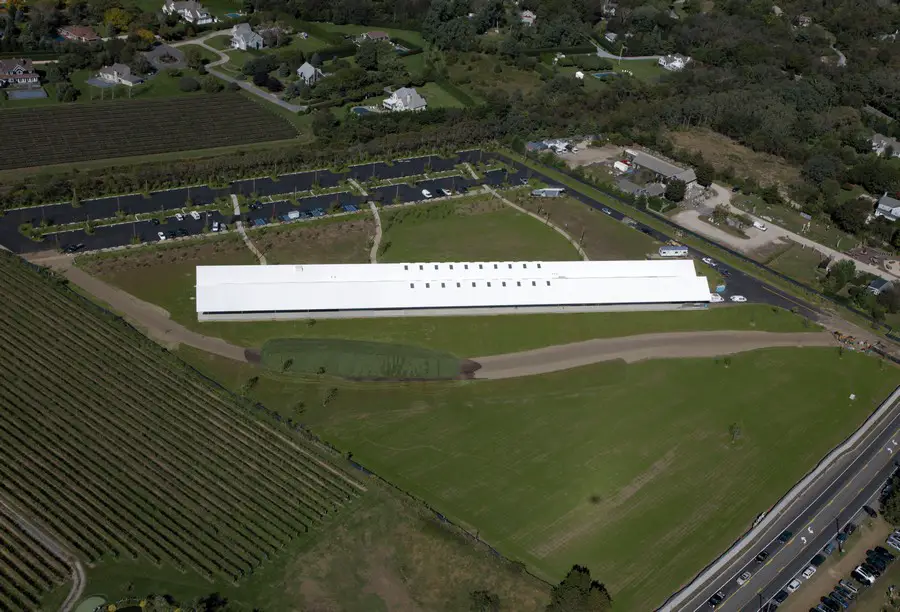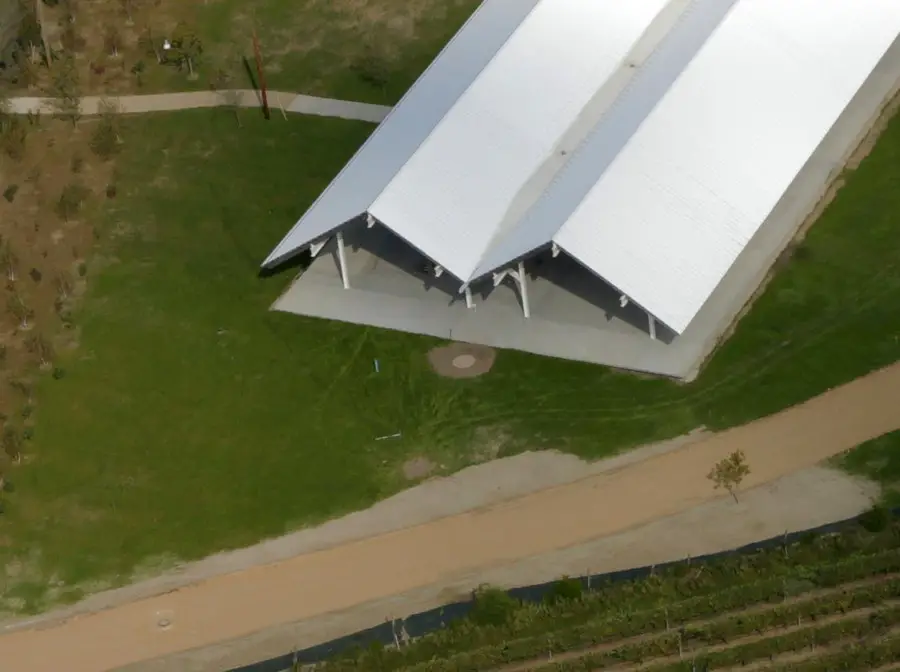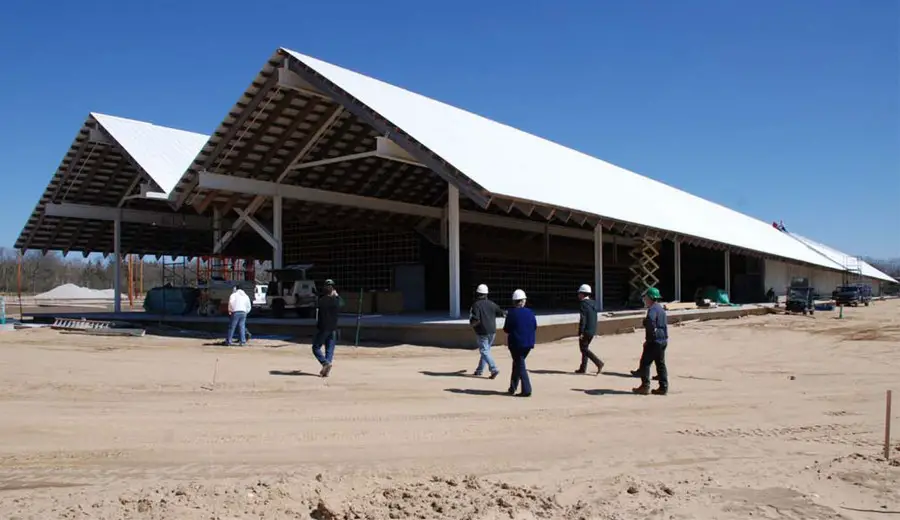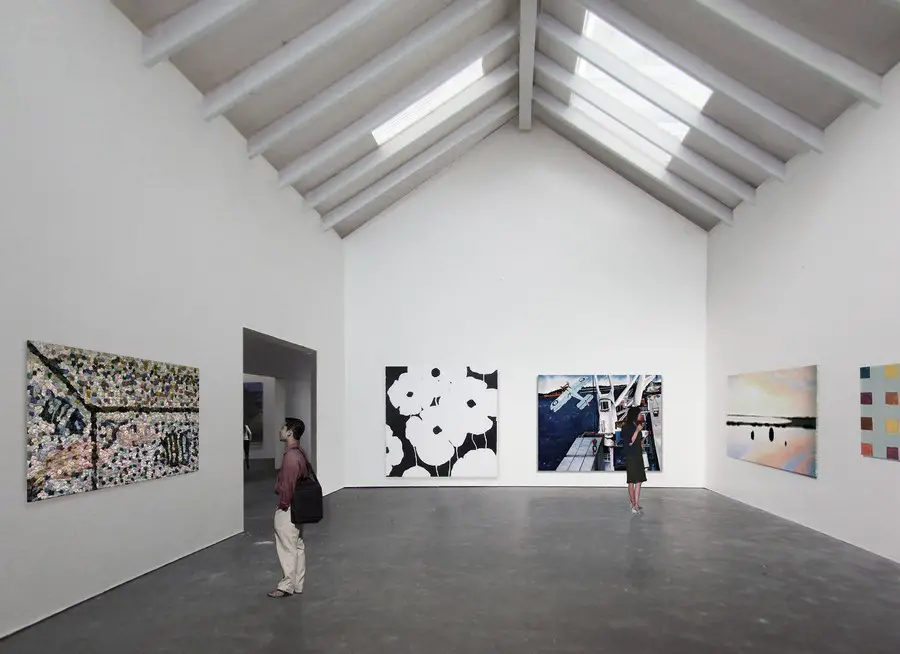
↗ 瑞士建築師 Herzog & de Meuron 設計的 New Parrish Art Museum 外觀電腦模擬圖

↗ 瑞士建築師 Herzog & de Meuron 設計的 New Parrish Art Museum 內部電腦模擬圖

↗ New Parrish Art Museum 地面層平面圖

↗ New Parrish Art Museum 基地平面圖
出處:NYTimes
The New Parrish Art Museum Was Designed With Light in Mind
By ROBIN POGREBIN
Published: July 23, 2006
ARTISTS have long been drawn to this part of the world by the sharp clarity of the light and the saturated colors of the sky. The Swiss architects Jacques Herzog and Pierre de Meuron set out to capture those local qualities of inspiration in their design for a new Parrish Art Museum here on the eastern end of Long Island.
Typically, architects design museums with the art collection in mind; here, the architects also sought to design a museum befitting the artists. The two concepts are in any case intertwined, given that the Parrish’s collection embraces American art from the 19th century to the present day, particularly art created on the island.
In preparing to build from the ground up at a former tree nursery just two miles east of the museum’s current home, an Italianate-style building on Job’s Lane, the architects visited studios of artists both living (Chuck Close, Ross Bleckner) and dead (Willem de Kooning, Roy Lichtenstein). In studying their living and working conditions, they gained a sense of how local painters and sculptors became attached to the area.
They observed how artists created their studios in former farm buildings, sheds and shacks and oriented those spaces around the northern light. They noted that those work environments were kept open and spare — with white walls and white floors in many cases — and chatted with artists about the nuances of Long Island light.
“That’s how we start,” said Ascan Mergenthaler, the Herzog & de Meuron partner supervising the project. “The building has to be about the community, how the art is made.”
“Every time we came here, there was a different light and different sky, but always amazing,” he said. “It was important to bring that into the gallery spaces.” The architects also met with about 40 artists from the region.
“We talked about the respect for light,” said Michelle Stuart, a sculptor who attended one of the sessions. “It sounded like they were listening to the artists.”
Construction of the museum is expected to begin this fall, with a tentative opening date of June 2009.
The museum had outgrown its current building, an 1898 brick structure that lacks sufficient space for major exhibitions, storage and educational activities.
The architects’ response to the 14-acre site in Water Mill was to spread about 30 modest, low-slung buildings over the area, sandwiched between the Montauk Highway and the Long Island Rail Road tracks. With their varying shapes, angular roofs and local vegetation, the buildings look to be growing out of the ground.
The architects sought to strike a balance between honoring the prevailing local aesthetic — wood shingles, brick, farmhouse construction — and creating something strikingly modern. Several different building materials are under consideration, including brick, sand, glass, metal and wood.
The rooftops are slanted along the north ridge to bring the sun into the simple boxy galleries. Large skylights afford open upward views and are made of translucent glass to diffuse the light. The parking, arranged in a loop partly submerged in the ground, avoids the feel of a sprawling lot and leaves sight lines unimpeded by cars.
Mr. Mergenthaler said the layout was inspired in part by the Louisiana Museum of Modern Art north of Copenhagen, whose buildings are strung out in a verdant park overlooking a sound. “Architecturally, it’s not interesting, but it has a nice feeling because it’s so integrated into the landscape, the way it flows through it,” he said.
The architects started with a bubble diagram, a sketch used to propose an arrangement of spaces for a landscape environment or structure, with each bubble representing a component — for example, administration or exhibition. Eventually the bubble diagram became literal, with the new Parrish conceived as a complex of low buildings that flow into one another. “It’s really a loose collection of houses,” Mr. Mergenthaler said.
Green areas and meandering paths lend a casual and serendipitous air to the visitors’ circulation pattern. “It was very important for us to do something which was very much Long Island, which was very much Southampton,” Mr. Mergenthaler said, “only using indigenous plants, working with the seasons because the seasons change so much.”
Trudy C. Kramer, the museum’s director, said the architects “built this design around the experience of this place.”
Given the scale and prominence of some of Herzog & de Meuron’s previous projects — the Tate Modern in London (2000); the new de Young Museum in San Francisco, which opened last October; and the Walker Art Center expansion in Minneapolis (April 2005) — the Parrish may seem like small potatoes.
“The reason we wanted to do it was because of the location, the people,” Mr. Mergenthaler said, adding, “We’re going to tell a very specific architectural story, which makes it interesting to us.”
Located just off Main Street, the Parrish has been operating in its existing building since its founding by Samuel Longstreth Parrish, a Quaker lawyer and philanthropist. He built it to house his growing holdings of Italian Renaissance art and reproductions of classical Greek and Roman statuary — part of the founding collection, which is owned by the Village of Southampton.
Today the collection is dominated by the work of local artists like Mr. Close, Lichtenstein, de Kooning, Jackson Pollock, Lee Krasner, Dan Flavin and Elizabeth Peyton. Ms. Kramer noted that “a huge body” of artists — about 450 — have lived on the East End of Long Island since the 1890’s, a list based on research conducted by young scholars through the Otto Endowment Fund for the Study of Art of Eastern Long Island.
To accommodate the museum’s growing collection and big shows, its space will increase to 80,000 square feet — of which 64,000 will be completed by 2009 — from its current 25,000 square feet, which includes an adjacent library on Job’s Lane that will be kept as a satellite.
The village is hoping to house another arts group in the old building after the museum moves out, Ms. Kramer said.
The Parrish’s operating budget of $3.5 million is expected to rise to $5 million at the new site, she said. She estimated construction costs to be about $55 million to $65 million. A capital campaign will include an endowment drive.
The Parrish purchased the Water Mill property a year ago for $3.8 million after an expansion plan for its current site didn’t pan out. The Parrish had big ambitions: it drew up a list of 65 architect candidates before settling on Herzog & de Meuron last summer.
Mr. Kramer said she and the trustees particularly admired the firm’s design for the copper-paneled de Young, laid out in three parallel bands intersected by irregular landscaped courtyards, and its penchant for intimate spaces.
“We didn’t want the temple on the mount, the palace as the museum,” Ms. Kramer said. “We wanted a different kind of story physically and programmatically, and the buildings that they’ve done said that to us.”
Parrish officials also appreciated Herzog & de Meuron’s lack of an easily recognizable signature. “With certain architects, there is a vocabulary that repeats itself,” Ms. Kramer said. “With this firm, each building is different than the rest, and we wanted something different.”
Ms. Stuart, the artist, said she was encouraged by the design. “The building should follow topographically the land in the sense of not being a big surprise,” she said. “You wouldn’t want to see a Frank Gehry out here.”
The museum’s anchoring galleries will feature artists who figure prominently in the collection, like William Merritt Chase, a painter of Impressionist landscapes, portraits and still lifes, and Fairfield Porter, known for his realist depictions of the sea and coastal fields bathed in an unmistakably American light.
Envisioning the museum as a social destination for the village, the architects have also included a cafe, movie theater and shop. Mr. Close, the artist, said the new Parrish would give the local art a chance to shine.
A work that he paints on Long Island tends to disappoint him when he’s back in New York, he said, where the light is far more gray. Removed from the island’s sun, which reflects off the water and back into his studio, Mr. Close said, “there are all kinds of colors in there that you can’t see.”
“It will be exciting to see paintings that we thought we knew,’’ he added. “I think they’re just going to sing in this new space.”




